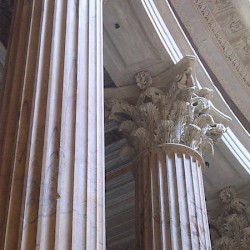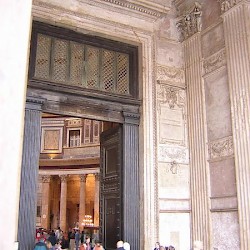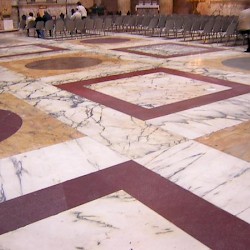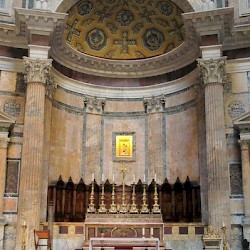Rome, Pantheon
Q99309Pantheon: temple in Rome, one of the best-preserved buildings of the ancient world, dedicated to "the all-divine" (i.e., heaven).
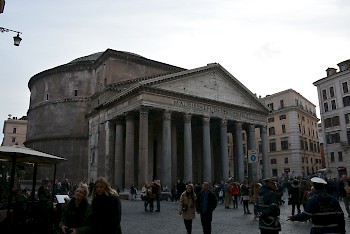
The Pantheon in Rome is one of the best-preserved buildings of the ancient world. Seen from the inside, it resembles a giant sphere with a diameter of 43.30 m. The Graeco-Roman historian Cassius Dio already was in doubt whether it was dedicated to "all gods" or "the all-divine" (i.e., heaven).
It has this name, perhaps because it received among the images which decorated it the statues of many gods, including Mars and Venus; but my own opinion of the name is that, because of its vaulted roof, it resembles the heavens. Agrippa, for his part, wished to place a statue of Augustus there also and to bestow upon him the honor of having the structure named after him; but when the emperor wouldn't accept either honor, he placed in the temple itself a statue of the former Caesar and in the ante-room statues of Augustus and himself.note
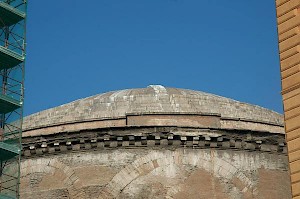
Dio is confusing two buildings. Agrippa, a close friend of the emperor Augustus, did indeed build a sanctuary named Pantheon on the Field of Mars: a circular open air sanctuary that played a role in the cult for the emperor. A wide lane connected that building with the Mausoleum of Augustus. It was destroyed by fire in 80 and restored by the emperor Domitian. Destroyed again under Trajan, it was rebuilt between 118 and 125 by the emperor Hadrian, and it was only then that it received its famous vaulted roof.
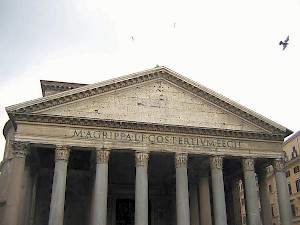
It is true that the inscription informs us that the building was built after Agrippa had been consul for the third time:note
M. Agrippa L.f. cos. tertium fecit.
This was in the year 27 BCE, but this is because Hadrian had the habit of reconstructing monuments under the names of the original builders. Because every Roman knew who was responsible for the rebuilding, he could be ostentatiously modest. A second line in the inscription refers to a restoration by Septimius Severus and Caracalla in 202 CE.note
Cassius Dio was right that the spherical shape of Hadrian's building represented the heavens. It was a very common idea. Hadrian's contemporary, the philosopher Plutarch, believed that circular temples were miniature copies of the universe.note But Agrippa's original design had nothing to do with heavens - in his age, a Pantheon was a sanctuary for a ruler.
Exterior
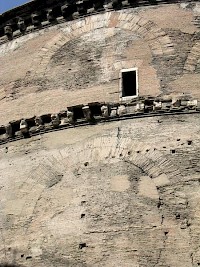
Today, the walls of the Pantheon have lost much of their splendor. Once, they were covered by white Pentelian white marble (from Athens) and stucco. Some remains are still visible.
Ante-room
In Antiquity, a visitor would have reached what Dio calls an "ante-room", i.e., the hall in front of the temple itself, after climbing four stairs of yellow marble from Numidia. This hall, which faces due north and was consequently almost lightless, was made from several kinds of natural stone from Egypt: the pavement was made of grey granite, purple porphyry decorated the walls, and the columns were made of grey and pink granite. White travertine and fragments of Lucullan black-red marble alternated with the Egyptian stones. Many people must have spent their siesta in the shade on this cool spot.
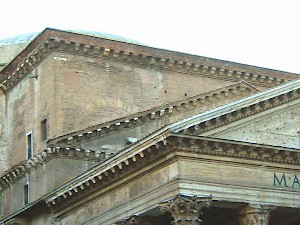
The fact that columns of different colors were used, is one of the arguments for the hypothesis that something has gone wrong. Probably, the original design called for an ante-room with taller columns, which for one reason or another never arrived. As a consequence, other columns had to be used. The triangle-shaped roof of the ante-room also fits rather awkwardly to the square substructure of the cupola. Few people will have noticed this construction error, because the Pantheon was surrounded by other buildings (e.g., the Baths of Agrippa).
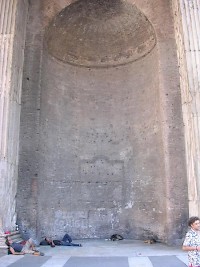
The ante-room was the site of the two statues of Augustus and Agrippa mentioned by Cassius Dio. According to Pliny the Elder, who was writing about Agrippa's Pantheon, there were statues of Caryatids in this hall as well,note but it is not known where they may have stood - if there were Caryatids at all in the Pantheon built by Hadrian.
A modern visitor will perhaps notice that the capitals of the ancient columns in the ante-room are all damaged, except for the three columns on the eastern side of the portico. (See the first and third photos above, and the first photo below.) The explanation is that they do not belong in the Pantheon at all. In 1666, the Pantheon was in need of repairs, and these columns were removed from the nearby Baths of Severus Alexander to be placed over here.
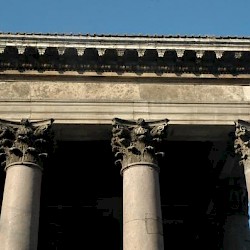 Rome, Pantheon, The perfectly preserved eastern capitals |
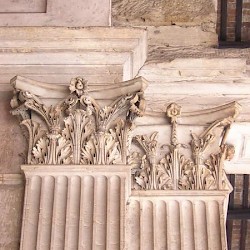 Rome, Pantheon, Narthex, Capitals |
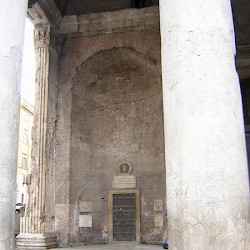 Rome, Pantheon, Narthex |
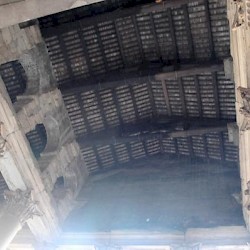 Rome, Pantheon, Narthex, Roof |
Interior
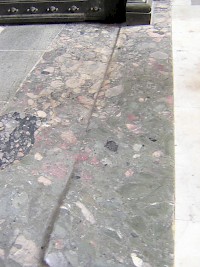
Crossing a large threshold (the world's largest known piece of Lucullan black and red marble) the visitor entered the sanctuary itself. The interior of the Pantheon must have been more surprising than it is today. In the first place, the Pantheon was constructed between other buildings, and the visitor cannot have known that he was about to enter a spacious vaulted room; in the second place, the contrast between the dark hall and the bright cult space - which is striking even today - must have been even more impressive in Antiquity, because the inner side of the dome was covered with gilded bronze. Since the conquests of Trajan in Dacia, this precious metal was in abundant supply. The gold must have reminded those who knew something about philosophy of the highest part of the earth's atmosphere, which was believed to consist of pure fire.
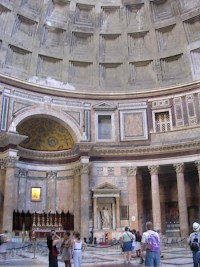
So the visitor entered the circular sanctuary which the emperor Hadrian had rededicated to the all-divine, i.e., heaven. Inside the rotunda were seven apses in which - as was once proposed by Theodor Mommsen - must have stood statues of the seven planets that, according to the ancients, moved around the earth; there was also a statue of Julius Caesar, the dictator who had, after his death, been recognized as a celestial god.
It is not recorded how the statues were arranged, but since the days of the Sicilian scientist Archimedes (287-212) it was customary to use a sequence based on revolution: Moon, Mercury, Venus, Sun, Mars, Jupiter, Saturn. If this sequence was also applied in the Pantheon, the statue of the Sun must have stood in the central apse, directly opposite the entrance.
On one side, the Sun had the three male planets: son Mars, father Jupiter, and grandfather Saturn; on the other side were Lady Venus, the androgynous Mercury, and Lady Moon. Saturn and the Moon were as far from the Sun as possible, in accordance with the ancient theory that they were the coldest planets. The favorable planets (Moon, Jupiter, Venus) and the unfavorable ones (Saturn, Mercury, Mars) constituted two equilateral triangles. In this way, the seven apses were a copy of the universe.
Platonic myth
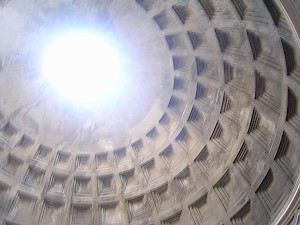
The most striking aspect of the vaulted space, however, was the big "eye" (oculus) in the top of the vault. Its function in the cosmological design had been described by the Athenian philosopher Plato, whose ideas were rapidly gaining popularity in the second century.
The gods see many blessed sights in the inner heaven, and there are many ways to and fro, along which the blessed gods are passing, every one doing his own work; he may follow who will and can, for jealousy has no place in the celestial choir. But when they go to banquet and festival, then they move up to the top of the vault of heaven. [...] For the immortals, when they are at the end of their course, go forth and stand upon the outside of heaven, and the revolution of the spheres carries them round, and they behold the things beyond. But of the heaven which is above the heavens, what earthly poet ever did or ever will sing worthily?note
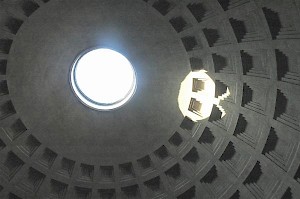
The point is that the gods do not only belong to our universe, but are also transcendental: they are beyond this world. This idea, which can for the first time be documented in the cult of Amun in ancient Egypt, was often combined with monotheism: the gods venerated by the Greeks and Romans were manifestations of the one, supreme being, the all-divine or Pantheon.
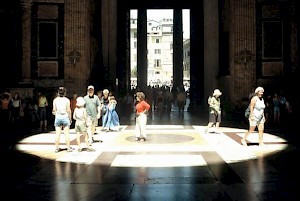
The movement of one the seven planets could be seen in the Pantheon as it was described by Plato: the projection of the Sun on the gilded ceiling, "moving up to the top of the vault of heaven" in winter when the Sun is low, and down in summer, when the Sun is high. In a sense, the Pantheon is a large planetarium. On the longest day of the year, 21 June, at astronomical noon, the light falls exactly in front of the entrance. If you would have entered the temple in Antiquity, you would have been absolutely blinded by the light, which appeared to come from the statue of the Sun.
Wonder of the world
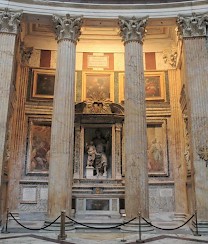
As indicated above, the rotunda was surrounded by apses in which the statues of the planets were standing. It is known from the Natural History by Pliny the Elder that the statue of Venus was decorated with earrings containing pearls that had once belonged to queen Cleopatra.note
The building was reckoned among Rome's greatest wonders. Writing in the late fourth century, Ammianus Marcellinus describes it as "a self-contained district under a high and lovely dome",note but it is not often mentioned in our sources. We know that Hadrian held court in this templenote and that the emperor Constantius II visited it in 357, and that's about it.
In 609, pope Boniface IV rededicated the Pantheon to S.Maria ad Martyres. Today, it is still in use as a church.
